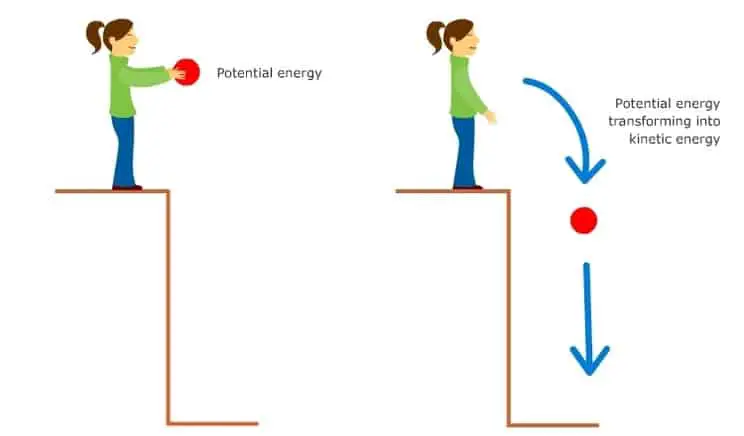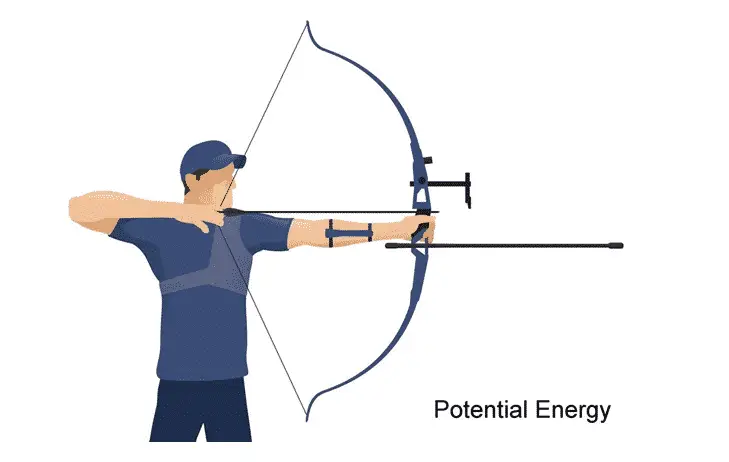Just like an object can either have a position or momentum (sometimes both). In a similar way, an object can have either kinetic energy or potential energy (sometimes both). In this article, we are only interested in the definition of potential energy.
However, I will still clear some air regarding the basic difference between kinetic and potential energy. See, when an object is in momentum (motion), it has energy in the form of kinetic energy. On the other hand, when an object is at rest (position), it has energy in the form of potential energy.
Moreover, when you add both of them, what you get is mechanical energy. In other words, the sum of kinetic and potential energy is Mechanical energy.
Potential Energy Facts
Did you know that an object can have both potential energy (due to its position) and kinetic energy (due to its motion) only and only in the case of the macroscopic world i.e Classical Physics, not in the microscopic world i.e Quantum Physics?
If an object can have both position (potential energy) and momentum (kinetic energy) in the quantum realm. It would directly violate the Heisenberg Uncertainty Principle.
Not to mention, there are some cases such as Quantum Entanglement where Heisenberg Uncertainty Principle does get violated. To know more about it, check out The EPR Paradox – A Thought, Myth, or, a Reality?
What is Potential Energy?
As I have already told you in the introductory paragraph that the energy stored in an object due to its position is known as potential energy. Well, not just because of its position, there are some other factors too.
In general, according to the definition of potential energy, it is the energy held by an object not only because of its position relative to other objects. But also because of the stresses within itself, its electric charge, or some other factors.
Check Out: Top 6 Uniform Motion Examples in SIX minutes (All NEW)
In fact, based on these factors that affect the potential energy of an object, it can be further dissected into several parts. Let’s talk about the different types of potential energy in the next section. Keep reading.
Potential Energy Facts
Did you know it was Aristotle who at first defined or I can say used the word potential energy? However, in modern terminology, the credit for coining the term potential energy is given to the 19th-century Scottish engineer and physicist William Rankine.
As Aristotle used to argue that motion is constituted by Potency and Being at Work. By motion, he meant mechanical energy. Similarly, by potency and being at work, he meant potential energy and kinetic energy. To know more about the work of Aristotle, especially in the field of Cosmology, check out Aristotelian Universe – Let’s Go Back in Time
Types of Potential Energy
There are several types of potential energy such as magnetic potential energy, electric potential energy, nuclear potential energy, chemical potential energy, and many more.
Out of all of its forms, in this article, we will be discussing two of the most common types of potential energy. These are gravitational potential energy and elastic potential energy. Let’s discuss both of them one by one in detail.
Must read: What is Nuclear Energy? – Definition, Facts, Types & Examples
Gravitational Potential Energy

According to the gravitational potential energy definition, it is the energy stored within an object due to its mass and the vertical height to which it is raised with respect to another massive object.
The heavier the object and the larger the distance between two objects, the larger will be the value of gravitational potential energy. In other words, gravitational potential energy is directly proportional to the mass and height of the object.
Some of the gravitational potential energy examples include a car at the top of the mountain, a book kept on the table, etc.
Must read: Nuclear Fission vs Nuclear Fusion – Difference in Tabular Form
Gravitational Potential Energy Formula
Well, there are two different ways to formulate the formula for gravitational potential energy.
1. When both masses are identical (like Earth and Mars System)

where,
U = Gravitational Potential Energy
G = Gravaitioanl Constant
M = Mass of Earth
m = Mass of Mars
R = Distance between earth and the Mars
Must read: What is Kinetic Energy? – Definition, Types & Examples
2. When one of the mass is too small i.e negligible (like Earth and human)

where,
U = Gravitational Potential Energy
m = Mass of a human
g = Gravity of Earth
h = Height of human from the surface of Earth
Gravitational Potential Energy Facts
Did you know that the above mentioned gravitational potential energy formula is based on Newtonian gravity? In Einsteinian gravity (general relativity), the gravitational potential is replaced by the metric tensor.
To put it differently, when the gravitational field is weak and the sources are moving too slow as compared to the speed of light, what we use is the gravitational potential (Newtonian Mechanics).
On the other hand, when the gravitational field is too strong (like black holes have) and the sources are moving comparable speed to the speed of the light. This is where we use a Metric tensor rather than using the orthodox gravitational potential.
Elastic Potential Energy

According to the elastic potential energy definition, it is energy stored in an object when an object or material or any kind of physical system is impermanently compressed, stretched, or generally deformed in any manner.
In layman, it is a type of potential energy due to the elasticity of an object. Some of the elastic potential energy include the coil spring of a wind-up clock, an archer’s stretched bow, etc. See the above image for proper understanding.
Take a look: Top 6 Sources of Mechanical Energy You Should Know
Elastic Potential Energy Formula
The formula for elastic potential energy is:

where,
U = Elastic Potential Energy
k = Elastic constant or simply spring constant
x = Compression or stretch in the length of the spring
Elastic Potential Energy Facts
Did you know that all the objects or materials that stores elastic potential energy has a threshold point? A point in the world of physics is known as the Elastic limit.
Not to mention, if the object or material is stretched beyond that elastic limit, it will be permanently distorted or broken apart.
Hence, as a result, a material will no longer be able to store elastic potential energy.
Potential Energy Examples in Everyday Life
If you think you can’t relate to potential energy examples in everyday life. Well, here is your chance to think again!
- The water behind the dam has gravitational potential energy.
- A coil spring of a wind-up clock.
- Firecrackers have chemical potential energy.
- A stretched bow has elastic potential energy.
- Book on a table has gravitational potential energy.
- A Yoyo has potential energy before it is released.
- A child at the top of the slide has gravitational potential energy.
- The battery has chemical potential energy.
- A stretched rubber has elastic potential energy.
- An atom has nuclear potential energy, etc.
That’s it for this post. If you like this article, share it if you like, like it if you share it. You can also find us on Mix, Twitter, Pinterest, and Facebook. Hey man, If you have come this far, do give us feedback in the comment section. It would make my day. You can also make a donation. Your donations will help us to run our website and serve you BETTER. Cheers!!!
You might also like:
- Top 6 Different Types of Energy with Their Examples (All New)
- Difference Between Uniform and Non-uniform Motion with Examples
- Top 6 Non-uniform Motion Examples in SIX Minutes
- Renewable Resources: Definition, Examples, Advantages, Disadvantages & its Future
- Nonrenewable Resources: Definition, Examples, Advantages, Disadvantages
